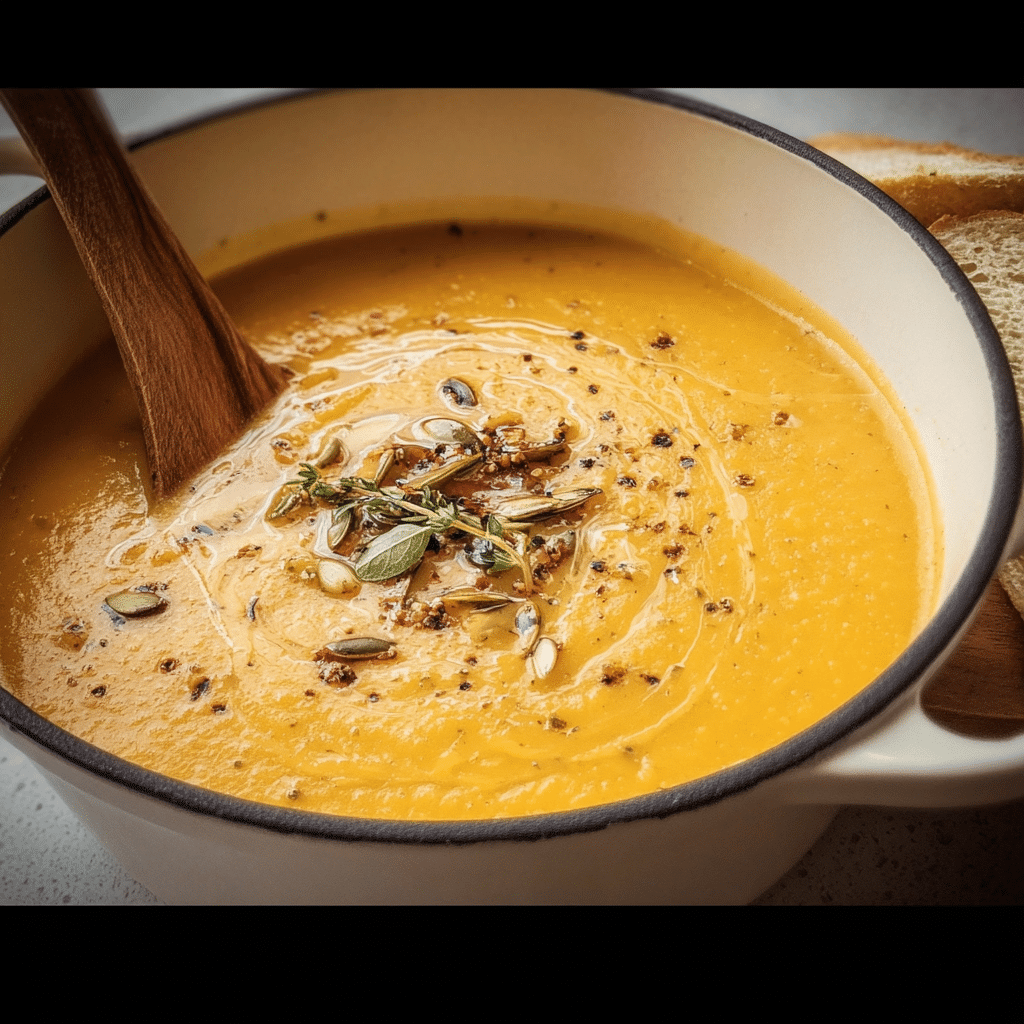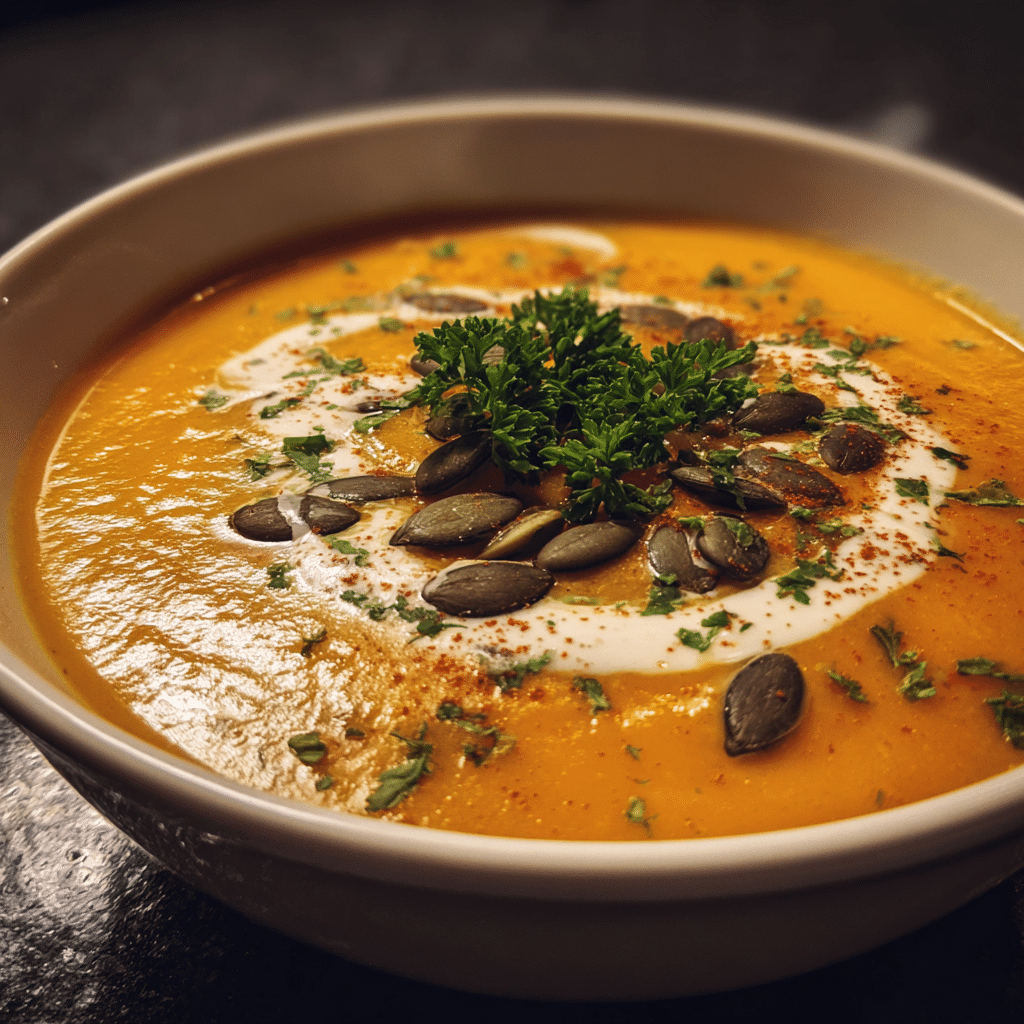Roasted butternut squash has a way of warming the soul, both in its rich flavor and its vibrant, golden hue. I still remember the first time I discovered this delightful soup. It was a chilly autumn evening, and I was at my friend’s house for a dinner party. As soon as I walked in, the aroma of roasted vegetables enveloped me, and I knew something special was being prepared. My friend, an avid cook, served a steaming bowl of roasted butternut squash soup topped with a drizzle of crème fraîche and a sprinkle of pumpkin seeds. The first spoonful was a revelation—sweet yet savory, it was the perfect blend of cozy and elegant. That moment ignited my passion for this dish, and I’ve been perfecting my recipe ever since.

The Story Behind This Recipe
What makes roasted butternut squash soup so special is not just the flavor, but the memories that come with it. As a busy mom, I often find myself running from one activity to the next, and the thought of preparing dinner can feel overwhelming. However, this soup is my go-to solution. It’s quick to whip up, and the ingredients are often seasonal and accessible. I can roast a batch of butternut squash on the weekend, then blend it into a creamy soup during the week when time is tight. It’s comforting, nourishing, and best of all, it brings my family together at the dinner table.
Historically, butternut squash has been a staple in many cultures, celebrated for its versatility and nutritional value. Originating from Central America, this squash was cultivated by indigenous peoples long before it made its way to European kitchens. Today, it’s a beloved ingredient in cuisines around the world, often featured in soups, salads, and roasted dishes. The beauty of roasted butternut squash soup lies in its adaptability. You can spice it up with curry, add a hint of maple syrup for sweetness, or keep it simple with salt and pepper. Each variation tells a story of its own, making it a canvas for culinary creativity.
Why You’ll Love This Dish
This dish is particularly perfect for busy families looking for quick dinner solutions because it can be made in bulk and stored for later. You can easily double the recipe and freeze portions for a quick meal later in the week. The soup’s creamy texture and balanced flavors are sure to please even the pickiest eaters. Plus, it’s packed with vitamins and minerals, making it a healthy option for everyone in the family.
Seasonal relevance is another reason to embrace roasted butternut squash soup. Autumn is the prime time for this squash, as farmers’ markets overflow with fresh produce. It’s a great way to celebrate the harvest season, and roasting the squash enhances its natural sweetness, creating a deliciously rich flavor. As the weather turns cooler, this soup becomes a comforting staple in my kitchen, reminding me of those early autumn evenings spent with friends and family.
Ultimately, the emotional connection I have with this dish runs deep. It represents warmth, comfort, and togetherness—elements that are often missing in our fast-paced lives. With this guide, I promise you will learn everything you need to know about making the perfect roasted butternut squash soup, from the best techniques to flavor combinations that will elevate your dish to the next level. So, grab your apron, and let’s get cooking!
The Rich History and Cultural Significance of roasted butternut squash
The roasted butternut squash has a rich history that traces back to ancient civilizations. This vibrant vegetable is native to the Americas, with origins believed to be in Central America and Mexico. Archaeological evidence suggests that butternut squash has been cultivated for over 5,000 years. It was a crucial food source for indigenous peoples, who recognized its nutritional value and long shelf life. The hearty flesh and sweet flavor made it a favorite among various tribes, who incorporated it into their diets alongside other staples like beans and corn.
Origins and History
As European settlers arrived in the Americas, they discovered the many uses of roasted butternut squash and brought it back to their own kitchens. Over time, this squash became a staple in North American cuisine, particularly in the northeastern United States and Canada. The sweet, nutty flavor of roasted butternut squash made it a natural fit for soups, and it soon gained popularity as a comforting dish during the cold winter months.
Traditionally, the preparation of butternut squash often involved simple roasting or boiling, but as culinary techniques evolved, so did the ways to enjoy this versatile vegetable. In modern kitchens, you’ll find roasted butternut squash used in a variety of forms—from purees to salads, casseroles, and of course, soups. Chefs around the world have embraced its adaptability, incorporating it into diverse cuisines, from Italian risottos to Thai curries, showcasing just how universal this humble squash can be.
Cultural Significance
In many cultures, roasted butternut squash holds a special place during festive occasions. In the United States, it is often featured in Thanksgiving meals alongside turkey and stuffing, symbolizing the harvest and abundance of the season. Similarly, in South America, squash is traditionally included in celebratory feasts, reflecting its importance in their agricultural heritage. The act of roasting the squash brings out its natural sweetness and creates a caramelized flavor that enhances any dish. It’s this transformation that makes butternut squash a beloved ingredient across various cuisines.
Famous chefs like Thomas Keller and Ina Garten have put their own spins on roasted butternut squash soup, elevating it from a simple dish to a culinary masterpiece. Their recipes often showcase the squash’s versatility, combining it with ingredients like ginger, garlic, or herbs to create complex flavor profiles. Restaurants around the world have also adopted this dish, offering unique interpretations that reflect local ingredients and culinary traditions.
Nutritional Benefits
Beyond its cultural significance, roasted butternut squash is packed with nutritional benefits that make it a great addition to any diet. This vibrant vegetable is rich in vitamins A and C, which are essential for maintaining healthy skin and a robust immune system. Additionally, butternut squash is a great source of fiber, promoting digestive health and helping to keep you feeling fuller for longer.
The antioxidants found in butternut squash, such as beta-carotene, provide further health benefits, including reducing inflammation and lowering the risk of chronic diseases. Its natural sweetness makes it a healthier alternative to sugary snacks, and incorporating it into your meals can help satisfy your sweet tooth without the guilt.
In conclusion, the history and cultural significance of roasted butternut squash extend far beyond its delightful taste. This beloved vegetable has been a staple in many diets for centuries, celebrated for its versatility, nutritional value, and comforting qualities. Whether you’re enjoying it in a warm bowl of soup or roasted as a side dish, butternut squash continues to bring people together, reminding us of the beauty of seasonal cooking and the joy of shared meals.
Essential Ingredients for Perfect roasted butternut squash
When it comes to making the perfect roasted butternut squash soup, the essence lies in the ingredients. Each component plays a critical role in shaping the flavor, texture, and overall experience of this comforting dish. Let’s dive into the essential ingredients that will help you create a soup that’s not only delicious but also nutritious.
Essential Ingredients
- Butternut Squash (2 medium-sized) – The star of our soup, butternut squash brings a natural sweetness and a creamy texture when roasted. Look for squash that feels heavy for its size, with a smooth, tan skin free of blemishes.
- Olive Oil (2-3 tablespoons) – A drizzle of high-quality extra virgin olive oil adds depth and richness to the soup. Use oil that is fragrant and fresh, as older oils can impart a bitter flavor.
- Onion (1 large) – Onion provides a foundational flavor. Opt for a yellow onion for a balanced sweetness. Choose firm onions with dry, papery skins and no soft spots.
- Garlic (4-5 cloves) – Fresh garlic will enhance the flavor profile of your soup. Look for plump cloves that are firm to the touch. Avoid any that are sprouting or soft.
- Vegetable Broth (4 cups) – A good quality vegetable broth is crucial for a rich flavor. You can make your own or opt for low-sodium varieties to control salt levels.
- Coconut Milk (1 can, optional) – For a creamier texture and a touch of tropical flavor, coconut milk is a fantastic addition. Choose full-fat coconut milk for the best creaminess.
- Ground Cinnamon (1 teaspoon) – This spice adds warmth and a hint of sweetness. Look for freshly ground cinnamon for the best flavor.
- Ground Nutmeg (1/2 teaspoon) – Nutmeg complements the sweetness of butternut squash beautifully. Always choose whole nutmeg and grate it yourself if possible for maximum freshness.
- Salt and Pepper (to taste) – Essential for seasoning your soup to perfection. Use kosher salt for a cleaner flavor and freshly cracked black pepper for a bit of heat.
- Fresh Herbs (such as thyme or rosemary, for garnish) – Fresh herbs add a pop of color and a burst of flavor. Choose vibrant, aromatic herbs that are free from wilting.
Understanding the role of each ingredient is key to mastering your roasted butternut squash soup. Butternut squash is the foundation, providing sweetness and creaminess, while onions and garlic build a savory base. Olive oil is essential for roasting, helping to caramelize the squash and enhance the flavors. The spices, cinnamon and nutmeg, are not just for flavor; they elevate the dish, making it feel warm and cozy.
Print
Roasted Butternut Squash Recipe
Ingredients
- 1 large butternut squash (about 3 pounds), halved vertically* and seeds removed
- 1 tablespoon olive oil, plus more for drizzling
- ½ cup chopped shallot (about 1 large shallot bulb)
- 1 teaspoon salt
- 4 garlic cloves, pressed or minced
- 1 teaspoon maple syrup
- ⅛ teaspoon ground nutmeg
- Freshly ground black pepper, to taste
- 3 to 4 cups (24 to 32 ounces) vegetable broth, as needed
- 1 to 2 tablespoons butter, to taste
Instructions
-
- Preheat the oven to 425 degrees Fahrenheit and line a rimmed baking sheet with parchment paper. Place the butternut squash on the pan and drizzle each half with just enough olive oil to lightly coat the squash on the inside (about ½ teaspoon each). Rub the oil over the inside of the squash and sprinkle it with salt and pepper.
- Turn the squash face down and roast until it is tender and completely cooked through, about 40 to 50 minutes (don’t worry if the skin or flesh browns—that’s good for flavor). Set the squash aside until it’s cool enough to handle, about 10 minutes.
- Meanwhile, in a large soup pot, warm 1 tablespoon olive oil over medium heat until shimmering (if your blender has a soup preset, use a medium skillet to minimize dishes.) Add the chopped shallot and 1 teaspoon salt. Cook, stirring often, until the shallot has softened and is starting to turn golden on the edges, about 3 to 4 minutes. Add the garlic and cook until fragrant, about 1 minute, stirring frequently. Transfer the contents to your stand blender (see notes on how to use an immersion blender instead).
- Use a large spoon to scoop the butternut squash flesh into your blender. Discard the tough skin. Add the maple syrup, nutmeg and a few twists of freshly ground black pepper to the blender. Pour in 3 cups vegetable broth, being careful not to fill the container past the maximum fill line (you can work in batches if necessary, and stir in any remaining broth later).
- Securely fasten the lid. Blend on high (or select the soup preset, if available), being careful to avoid hot steam escaping from the lid. Stop once your soup is ultra creamy and warmed through.
- If you would like to thin out your soup a bit more, stir in the remaining cup of broth. Add 1 to 2 tablespoons butter or olive oil, to taste, and blend well. Taste and stir in more salt and pepper, if necessary.
- If your soup is piping hot from the blending process, you can pour it into serving bowls. If not, pour it back into your soup pot and warm the soup over medium heat, stirring often, until it’s nice and steamy. I like to top individual bowls with some extra black pepper.
Shopping Tips
When sourcing ingredients for your roasted butternut squash soup, consider shopping at local farmers’ markets during the fall and winter months when butternut squash is in season. This not only ensures freshness but also supports local agriculture. Look for squash that is firm and heavy, with a dull, matte finish.
For items like onions and garlic, choose organic if possible, as these often have more robust flavors and fewer pesticides. Organic vegetable broth is also a great option, giving you a cleaner taste without harmful additives.
Substitutions and Alternatives
If you have dietary restrictions or preferences, there are plenty of substitutions available. For a vegan version, stick with vegetable broth and omit any dairy. If you’re dairy-free, coconut milk is a fantastic alternative to heavy cream, adding a rich texture without the lactose.
For those avoiding nuts, you can replace coconut milk with almond milk or another plant-based milk, although the flavor will differ slightly. If you’re looking to cut down on calories, you can reduce the amount of olive oil or use a cooking spray. Finally, if butternut squash isn’t available, other varieties like acorn or kabocha squash can be used, although the flavor profile will change slightly.
Storage is another important consideration. Whole butternut squash can last for several months in a cool, dark place. Once cut, store it in the refrigerator in an airtight container, where it will last for about a week. Garlic and onions should be kept in a cool, dry place, while vegetable broth can be frozen in portions for up to six months.
Overall, the ingredients you choose will greatly influence the final taste of your roasted butternut squash soup. By selecting fresh, high-quality components and understanding their roles, you’ll be well on your way to creating a comforting bowl of this delightful dish.
Detailed Step-by-Step roasted butternut squash Cooking Instructions
Creating a bowl of delicious roasted butternut squash soup is not just about the ingredients; it’s about the process and experience of cooking. Whether you’re a seasoned chef or a home cook, the joy of preparing this soup lies in the detailed steps that lead to a warm, comforting final product. Let’s walk through the cooking process step by step.
Preparation Steps
- Gather Your Ingredients: Start by assembling all your ingredients. This includes your butternut squash, onions, garlic, vegetable broth, spices, and any garnishes you plan to use. Having everything within reach will make the cooking process smoother and more enjoyable.
- Preheat the Oven: Preheat your oven to 400°F (200°C). This is the perfect temperature for roasting the squash, allowing it to caramelize beautifully.
- Prepare the Butternut Squash: Carefully slice the ends off your butternut squash and cut it in half lengthwise. Scoop out the seeds with a spoon. If you’re unsure how to peel it, you can roast it first and scoop the flesh out later, or use a vegetable peeler for a simpler approach. Cut the squash into cubes, roughly 1-inch in size.
- Prep the Onion and Garlic: Dice your onion into small pieces and mince the garlic. Remember to wash your hands after handling garlic, as the smell can linger. If you have a garlic press, now is the time to use it for quick mincing!
- Toss with Olive Oil: In a large mixing bowl, combine the cubed butternut squash with olive oil, salt, and pepper. Toss well to ensure the squash is evenly coated. This step is crucial for achieving that caramelized flavor and golden color during roasting.
Cooking Process
- Roast the Squash: Spread the butternut squash cubes in a single layer on a baking sheet lined with parchment paper. Roast in the preheated oven for about 25-30 minutes, or until the squash is fork-tender and begins to brown. You’ll know it’s ready when it’s caramelized and fragrant. Give it a stir halfway through to ensure even cooking.
- Sauté the Aromatics: While the squash is roasting, heat a tablespoon of olive oil in a large pot over medium heat. Add the diced onion and sauté until translucent, about 5-7 minutes. Then, add the minced garlic and sauté for an additional minute until fragrant. Be careful not to let the garlic burn, as it becomes bitter.
- Add the Roasted Squash: Once the squash is done roasting, add it directly to the pot with the onions and garlic. This combination of flavors is what makes the soup truly special.
- Incorporate Broth and Spices: Pour in the vegetable broth and add the ground cinnamon and nutmeg. Stir everything together, ensuring that the spices are well-distributed. Allow the mixture to simmer for about 10-15 minutes. This step helps the flavors meld beautifully.
- Blend the Soup: After simmering, it’s time to blend! Using an immersion blender, carefully puree the soup until it’s smooth and creamy. If you don’t have an immersion blender, you can transfer the soup in batches to a regular blender. Just be cautious, as hot liquids can splatter.
- Final Touches: Once blended, return the soup to the pot (if using a regular blender) and stir in the coconut milk if desired. This adds a delicious creaminess. Taste and adjust seasoning with more salt and pepper as needed. If the soup is too thick, add a bit more broth or water to reach your desired consistency.
Final Assembly
- Serve: Ladle the hot soup into bowls and garnish with fresh herbs, a drizzle of olive oil, or a sprinkle of cinnamon for a beautiful presentation. You can also add a dollop of yogurt or sour cream for extra richness.
- Pairing Suggestions: This roasted butternut squash soup pairs wonderfully with crusty bread or a simple salad. If you want to make it a complete meal, consider adding some protein like grilled chicken or chickpeas.
- Storage: Leftovers can be stored in an airtight container in the refrigerator for up to a week or frozen for up to three months. Just reheat gently on the stove or in the microwave, adding a splash of water or broth to loosen it up if needed.
Cooking roasted butternut squash soup can be a delightful experience filled with warmth and comfort. By following these detailed steps, you’ll not only create a delicious dish but also develop your skills in the kitchen. The rich flavors and creamy texture of this soup are sure to bring smiles around the dinner table, making it a perfect choice for family gatherings or a cozy night in.
Professional Tips and Techniques for roasted butternut squash
When it comes to making the perfect roasted butternut squash soup, the journey begins long before the soup pot is even on the stove. Understanding the nuances of roasting butternut squash and mastering the art of soup-making can elevate your dish from ordinary to extraordinary. As someone who has spent years experimenting with different techniques in the kitchen, I’ve gathered some professional tips and techniques that will help you create a flavor-packed roasted butternut squash soup that will warm your heart and delight your taste buds.
Professional Techniques
Roasting is the key to unlocking the natural sweetness of butternut squash. To achieve that deeply caramelized flavor, begin by preheating your oven to a robust temperature of around 425°F (220°C). This high heat not only helps in browning the squash but also enhances its flavor profile. When preparing the squash, cutting it into uniform cubes—about 1-inch in size—ensures that each piece cooks evenly. I recommend using a large, sharp chef’s knife for this task. The beauty of butternut squash lies in its firm flesh, but it can be a bit tricky to slice. Don’t hesitate to invest in a sturdy vegetable peeler to remove the tough skin; it will make your prep work much easier.
Once your squash is diced, it’s time to coat it with a generous drizzle of olive oil. The oil not only aids in roasting but also contributes to the overall richness of the soup. Toss the cubes in a bowl with salt, pepper, and optional spices such as cumin or paprika for an added depth of flavor. Spread the cubes in a single layer on a baking sheet lined with parchment paper to avoid sticking and ensure even roasting.
Roast the squash for about 25-30 minutes, flipping halfway through, until the edges are caramelized and the flesh is tender. This step is crucial; the caramelization process enhances the sweetness and draws out rich flavors that will form the base of your soup. If you want to get adventurous, consider adding whole garlic cloves or onions to the roasting pan. This will infuse your soup with an aromatic sweetness that is absolutely divine.
Troubleshooting Guide
Even seasoned cooks face challenges when preparing roasted butternut squash soup. One common issue is the soup being too thick or too thin. If your soup turns out thicker than desired, simply add more vegetable or chicken broth until you reach your preferred consistency. Conversely, if the soup is too thin, try simmering it for a few more minutes to allow excess liquid to evaporate or blend in a bit more roasted squash to thicken it up.

Another common problem is that the soup may lack depth in flavor. If you find yourself in this situation, consider adding a splash of apple cider vinegar or a squeeze of fresh lemon juice to brighten the flavors. This little trick can lift the soup and bring all the ingredients together beautifully. Additionally, try experimenting with different herbs and spices. Thyme, nutmeg, and even a hint of cinnamon can create a wonderful aromatic profile that complements the squash.
Presentation Tips
The final presentation of your roasted butternut squash soup can be as delightful as its taste. Serve it in a warm bowl and consider garnishing with a drizzle of cream or coconut milk for a touch of elegance. A sprinkle of freshly chopped herbs like cilantro or parsley adds a vibrant pop of color that contrasts beautifully with the golden soup. Toasted pumpkin seeds or croutons can provide a satisfying crunch, making each bite a delightful experience.
When it comes to pairing your soup with a beverage, a crisp white wine, such as Sauvignon Blanc or a light-bodied red like Pinot Noir, complements the rich flavors of the soup beautifully. If you’re looking for a non-alcoholic option, a refreshing apple cider can work wonders, echoing the natural sweetness of the butternut squash.
Lastly, if you are looking to make-ahead, this soup keeps well in the refrigerator for up to five days and can also be frozen for up to three months. Just be sure to cool the soup completely before transferring it to an airtight container. When you’re ready to enjoy, simply reheat it on the stove over low heat, stirring occasionally.
Creative Variations and Adaptations of roasted butternut squash
The beauty of roasted butternut squash soup lies in its versatility. While the classic recipe is comforting and delicious, there are countless ways to adapt and personalize this dish to suit your palate or dietary needs. Whether you’re looking to experiment with seasonal ingredients or explore international flavors, here are some creative variations and adaptations to inspire your next cooking adventure.
Seasonal Variations
As the seasons change, so too can your butternut squash soup. In the fall, consider adding freshly harvested apples to the mix. The natural sweetness of apples pairs wonderfully with roasted squash, creating a cozy and inviting flavor. Simply roast the apples alongside the squash, and blend them into the soup for an autumnal delight.
In winter, you might want to add some hearty greens like kale or Swiss chard. Sauté them in a bit of olive oil before blending them into the soup. This not only adds nutrition but also a beautiful green hue that contrasts beautifully with the orange squash. Alternatively, during the summer months, try incorporating fresh herbs like basil or mint for a lighter, more refreshing version of the soup.
Dietary Adaptations
For those following specific dietary restrictions, roasted butternut squash soup can easily be modified. If you’re looking to keep things keto-friendly, consider substituting the broth with coconut milk to create a creamy consistency without the carbs. For a vegan version, simply skip the cream and use vegetable broth as your base. You can also enhance the soup with a variety of plant-based proteins, such as lentils or chickpeas, to make it heartier.
Gluten-free enthusiasts can rejoice as this soup naturally fits into gluten-free diets. Just double-check your broth to ensure it is certified gluten-free. For those who are dairy-free, the use of coconut milk or cashew cream can add richness without compromising on creaminess.
Creative Twists
When it comes to adding a twist to your roasted butternut squash soup, the possibilities are endless. How about a spicy version? Add a diced jalapeño or a pinch of cayenne pepper to the mix before blending for a warm kick. If you love global flavors, consider incorporating Thai red curry paste for a delicious fusion experience. The coconut milk and the spices will elevate your soup to a whole new level.
Another fun idea is to transform leftover soup into a pasta sauce! Simply thicken it with some additional cheese and serve it over your choice of pasta for a comforting meal. You can also mix it into risotto for a creamy, luscious dish that celebrates the flavors of fall.
By experimenting with these variations, you can create a roasted butternut squash soup that not only satisfies your craving but also adapts to the season, dietary needs, and personal taste. With each new twist, you’ll find yourself falling more in love with this versatile ingredient and all the delicious possibilities it holds.
Storage, Reheating, and Meal Prep for roasted butternut squash
When it comes to enjoying a warm, creamy bowl of roasted butternut squash soup, proper storage and reheating methods can significantly enhance your culinary experience. Whether you’re batch cooking for meal prep or enjoying leftovers from a cozy dinner, understanding how to store and reheat your soup is crucial for maintaining its delicious flavor and texture. Let’s dive into the details.
Short-term Storage
If you find yourself with leftover roasted butternut squash soup after a delightful dinner, short-term storage in the refrigerator is a breeze. First, ensure that the soup has cooled to room temperature before transferring it to a container. Using airtight containers is key here. Glass containers are my personal favorite, as they don’t retain odors and are microwave-safe. Alternatively, high-quality plastic containers will work just fine.
For best results, portion out the soup into servings. This not only makes reheating easier but also helps you control portions if you’re watching your intake. Label each container with the date to keep track of freshness. Generally, roasted butternut squash soup can be stored in the fridge for up to 3-5 days. However, always use your senses; if it smells off or looks unusual, it’s best to err on the side of caution and discard it.
Freezing and Long-term Storage
If you want to extend the life of your roasted butternut squash soup even further, freezing is an excellent option. To do this, allow the soup to cool completely, then transfer it into freezer-safe containers or heavy-duty freezer bags. If using bags, lay them flat in the freezer; this makes them easier to stack and saves space. Be sure to leave some headspace in the containers, as liquids expand when frozen.
When it comes to freezing, the soup can last for up to 3 months. To maintain the best quality, try to consume it within the first month. I always recommend double-checking your freezer’s temperature; it should be set to 0°F (-18°C) or lower. Before you freeze, you might want to consider omitting any cream or dairy if you plan to reheat the soup later, as these ingredients can separate and affect the texture upon reheating.
Reheating Best Practices
Reheating your roasted butternut squash soup can be done in several ways, depending on your preferences and the time you have available. The stove is my go-to method because it allows for gentle heating and even distribution of warmth. Simply pour the soup into a pot, add a splash of water or vegetable broth to help regain that silky texture, and heat it over medium-low heat, stirring occasionally until warmed through.
If you’re short on time, the microwave can also work wonders. Transfer your soup to a microwave-safe bowl, cover it loosely with a lid or microwave-safe wrap, and heat in 1-minute intervals, stirring in between to prevent hot spots. Just remember to check the temperature before serving, as microwaves can create uneven heating.
In terms of food safety, always make sure your soup reaches an internal temperature of 165°F (74°C) before consuming it. This is crucial to eradicate any bacteria that may have developed during storage. If you notice any signs of spoilage after reheating, such as off-odors or changes in color, it’s best to throw it out.
For meal prep enthusiasts, consider incorporating roasted butternut squash soup into your weekly routine. Not only is it a nutritious choice, but it also freezes beautifully, making it an ideal candidate for batch cooking. Prepare a large batch on the weekend, portion it out, and freeze what you won’t consume within the week. This way, you’ll have a comforting meal ready to go on those busy weeknights.
In conclusion, mastering the art of storage, freezing, and reheating your roasted butternut squash soup can elevate your dining experience and minimize waste. By following these guidelines, you can enjoy the rich, velvety flavors of this delightful dish any day of the week!
Nutritional Benefits and Health Information
When it comes to the nutritional benefits of roasted butternut squash soup, it’s not just a delicious comfort food; it’s also packed with an array of nutrients that can support your health. Understanding the nutritional profile can help you appreciate this dish even more and encourage you to incorporate it into your regular meal rotation.
Nutritional Profile
A typical serving of roasted butternut squash soup contains a wealth of vitamins and minerals. Butternut squash itself is rich in vitamin A, providing a powerful dose of beta-carotene, which is essential for eye health and immune function. A single cup of cooked butternut squash contains approximately 82 calories, 22 grams of carbohydrates, 2 grams of protein, and less than 1 gram of fat. It’s also high in dietary fiber, which is excellent for digestive health.
Aside from the squash, many recipes include ingredients like onions, garlic, and vegetable broth, all of which contribute additional nutrients. For instance, garlic is known for its immune-boosting properties, while onions are rich in antioxidants. If your recipe calls for cream, keep in mind that this will increase the caloric content, but it also adds richness and enhances flavor.

Health Benefits
The health benefits of roasted butternut squash soup are numerous. The high fiber content can aid in digestion and promote a feeling of fullness, making it a great option for those looking to manage their weight. Furthermore, the antioxidants present in butternut squash can help combat oxidative stress in the body, potentially reducing the risk of chronic diseases.
Additionally, this soup is a fantastic source of potassium, which is essential for heart health. A diet rich in potassium can help lower blood pressure and reduce the risk of stroke. The vitamin C found in butternut squash also plays a vital role in collagen production, which is important for skin health and wound healing.
Dietary Considerations
When it comes to dietary considerations, roasted butternut squash soup can easily be adapted for various eating plans. For those following a vegan or vegetarian lifestyle, simply use plant-based broth and omit any dairy. This soup is naturally gluten-free, making it suitable for those with gluten sensitivities. If you’re watching your carb intake, keep in mind that while butternut squash does contain carbohydrates, its fiber content makes it a healthier choice compared to refined carbs.
Alternatives and modifications can also enhance the nutritional profile of the soup. Adding in legumes, such as lentils or chickpeas, can increase protein content and make the soup even more filling. Incorporating leafy greens like spinach or kale can boost the vitamin and mineral content while adding a beautiful green color.
In comparison to similar dishes, roasted butternut squash soup stands out as a nutrient-dense option. For example, creamy potato soups can often be higher in calories and lower in fiber. The unique flavors of butternut squash combined with spices like nutmeg or cinnamon create a comforting and satisfying meal that is both delicious and healthful.
In conclusion, the nutritional benefits of roasted butternut squash soup make it an exceptional choice for anyone looking to enjoy a warm, hearty meal while also nourishing their body. By understanding its nutritional profile and exploring various adaptations, you can savor this delightful soup while reaping its many health benefits.
Frequently Asked Questions About Roasted Butternut Squash
Roasted butternut squash soup with coconut milk
Roasted butternut squash soup with coconut milk is a delicious and creamy dish that combines the natural sweetness of butternut squash with the rich flavor of coconut milk. To make this soup, start by roasting the squash until it’s tender and caramelized, which enhances its sweetness. After blending the roasted squash with sautéed onions, garlic, and vegetable broth, add coconut milk for a smooth texture and a touch of tropical flavor. For an added kick, consider incorporating spices like ginger or curry powder. Serve it garnished with fresh herbs or a drizzle of coconut milk for a beautiful presentation.
Roasted butternut squash soup Jamie Oliver
Jamie Oliver’s roasted butternut squash soup is known for its simplicity and vibrant flavors. He emphasizes using fresh, seasonal ingredients, suggesting roasting the squash with olive oil, salt, and pepper to enhance its natural taste. Once roasted, blend the squash with a combination of onions, garlic, and stock for a hearty base. Oliver often recommends adding a splash of apple cider or lemon juice to brighten the flavors. For a unique twist, you could also add a hint of chili for some heat or top the soup with crispy bacon or croutons for added texture.
Simple roasted butternut squash soup
A simple roasted butternut squash soup can be made with just a few key ingredients, making it a perfect go-to recipe for busy weeknights. Begin by cutting the squash in half, removing the seeds, and roasting it with a drizzle of olive oil and a sprinkle of salt until it’s soft. After roasting, scoop the flesh into a pot with sautéed onions and garlic, then add vegetable or chicken broth to achieve your desired consistency. Blend until smooth, and adjust seasoning as needed. To keep it simple yet flavorful, consider adding a dash of nutmeg or cinnamon for warmth.
Best roasted butternut squash soup
The best roasted butternut squash soup often involves a balance of flavors and textures, achieved through the careful selection of ingredients and cooking methods. Start by roasting the squash at a high temperature to develop caramelization, which adds depth to the flavor. Incorporate aromatics like onions and garlic for a savory base, and blend them with the squash and a good quality stock. To elevate the dish, consider adding a splash of cream or coconut milk for richness, and finish with fresh herbs or a squeeze of lime to brighten the flavor. Tasting and adjusting the seasoning throughout the process is key to achieving the perfect balance.
Conclusion: Mastering the Perfect roasted butternut squash
Creating the perfect roasted butternut squash is more than just following a recipe—it’s about understanding the techniques, ingredients, and cultural significance behind this beloved dish. Throughout this comprehensive guide, we’ve explored everything from the historical origins to modern variations, ensuring you have all the knowledge needed to make this recipe your own.
Whether you’re a beginner cook or an experienced chef, the techniques and tips we’ve shared will help you create a roasted butternut squash that’s not only delicious but also meaningful. Remember that cooking is a journey of discovery, and each time you make this dish, you’ll learn something new.
We encourage you to experiment with the variations we’ve discussed, adapt the recipe to your dietary needs, and most importantly, share it with the people you love. Food has the incredible power to bring people together, and Roasted Butternut Squash Soup is the perfect dish to create lasting memories around your dinner table.





